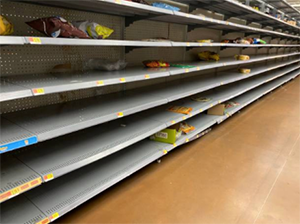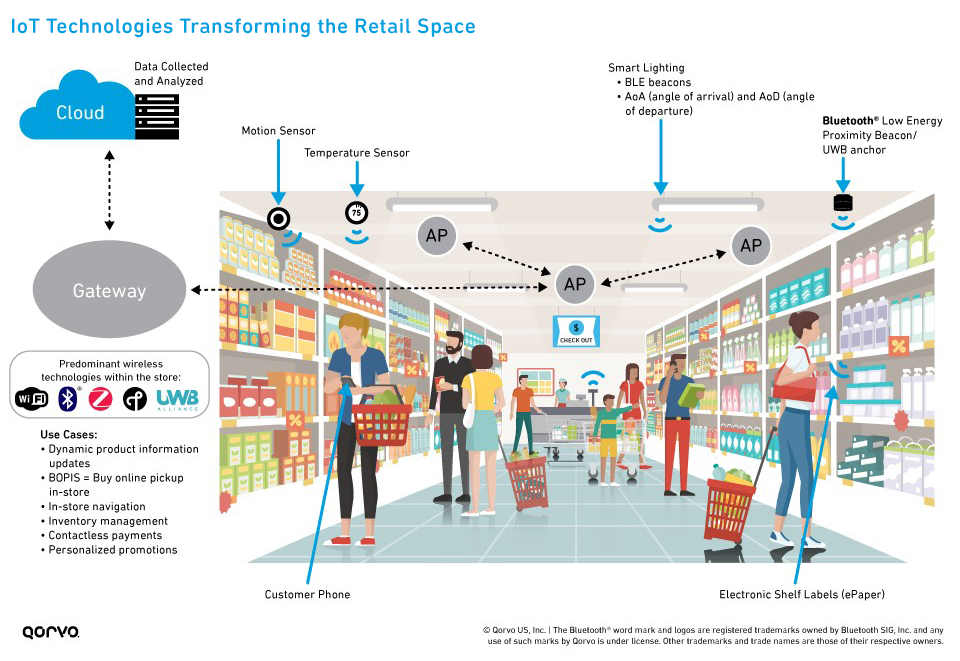Transforming the Retail Experience – Top Four RF Opportunities
May 15, 2020
The global coronavirus crisis is placing unprecedented pressure on the retail industry. Brick-and-mortar retail spaces, like grocery stores and pharmacies, have new protocols to keep customers and employees safe. There’s high demand for specific products, such as flour, eggs and toilet paper, making it difficult to continually keep shelves stocked. There’s also an uptick in home delivery requests. This ‘new normal’ has shaken consumer confidence as evidenced by declines in consumer spending across the world. In the U.S. alone, Fitch Ratings predicts that retail discretionary spending will drop by 40-50 percent in the first half of 2020. This has been further compounded by lockdowns and other disruptions to free movement of people and goods.
Retail is not just seeing a drop in demand. The coronavirus has also triggered a shift in consumer behavior as more spending moves from physical stores to online, even for products that people traditionally bought “offline.” According to Nielsen, in the two weeks that ended March 21, 2020, online shopping for consumer products in the U.S. increased by 35 percent compared with a typical week.
While it’s unknown how consumer behavior will adapt, retailers will likely accelerate the integration of their online and offline presence if they haven’t already. They will also double down on investment in Smart Retail solutions that strengthen their position amid this transformation of retail, whether that’s improving operational robustness or enabling new service offerings.
 A common scene in many regions around the world: Almost empty product shelves at a supermarket due to the coronavirus outbreak in 2020
A common scene in many regions around the world: Almost empty product shelves at a supermarket due to the coronavirus outbreak in 2020
With the adoption of Smart Retail solutions, stores are no longer merely a space for transactions. They are becoming an innovation lab, using real-time data to make decisions, and apply learnings for the benefit of both online and in-store customers. The goal of Smart Retail is to personalize and enrich the buyer experience, and ultimately increase customer loyalty, enhance operational efficiencies and maximize revenue.
IoT is essential for facilitating the retail transformation, and RF devices are vital to enabling IoT. They are integrated into the next-generation Smart Retail systems for a wide range of connected sensors, connectivity to a hub or gateway, and cloud intelligence.
This blog outlines the top four IoT opportunities where RF designs play a significant role in the evolving retail space.
1. Electronic Shelf Labels (ESL)
A variety of retail businesses – from grocery to hardware and consumer electronics stores – are rapidly adopting Electronic Shelf Labels, which retailers place on the retail shelves to update product information. According to Verified Market Research, the global Electronic Shelf Label market was valued at $462.34 Million in 2018 and is projected to reach $1,638.39 Million by 2026, growing at a CAGR of 17.47 percent from 2019 to 2026.
ESL systems are battery-powered devices placed on the retail shelf and include a display (i.e., e-Paper) that graphically shows product information such as price and sales promotions. These ESL systems are connected through low-power wireless communications to the store mesh network. The data is simultaneously delivered from a central server to thousands of tags located in the store.

2. Smart Lighting
Analysts assert that, as a whole, the smart lighting market will grow from USD 7.9 billion in 2018 to USD 21.0 billion by 2023 – a compound annual growth rate (CAGR) of 21.5 percent during the forecast period. Wireless installations and new applications are enabling much of this growth. In retail, smart lighting using Bluetooth® Low Energy (LE) technology or angle of arrival (AoA) receivers are creating opportunities for operational efficiencies and enriched in-store customer experience, similar to those offered by ESL.
Because light fixtures double as Bluetooth LE beacons, it allows retailers to communicate with Bluetooth-enabled devices, such as customer smartphones, coupling the online and brick-and-mortar experiences. These communications aid in location-based services – helping customers locate products or assisting with their requests. Businesses can also send information to customers’ phones, notifying them of promotions, up-selling or cross-promoting for specific products, as well as offering them loyalty rewards. These connections with customer devices provide retailers with insight used for a variety of business improvements and better customer experiences. The adoption of Ultra-Wideband (UWB) in flagship smartphones opens up possibilities for much more precise, reliable indoor positioning and navigation than would be possible with BLE alone.
Smart lighting also helps reduce energy consumption. Lighting systems with Bluetooth LE beacons allow retailers to regulate lighting throughout the store. The beacons can sense traffic and light areas of the store where there are people and dim lights when there is no traffic. The sensors also determine when and where light is coming from – such as daylight – and dim the lights in that area. For retailers, reduced energy consumption translates to reduced operating costs and maximized revenue.
3. Other IoT Sensors
IoT sensors go well beyond ESL and lighting. Other use cases include temperature, motion, and on-shelf sensors – all playing significant roles in higher in-store operational efficiencies, more effective warehouse management and overall better customer experience.
Temperature Sensors
Combined with a wireless communication network, temperature sensors strategically placed throughout the retail space provide valuable insight into the customer experience, as well as improve operations and reduce costs.
Temperature sensors can pick up customers’ body heat and monitor their movements throughout the store, providing data on customer traffic and how they are using the store. Sensors placed in grocery and convenience stores can monitor food temperatures to ensure freshness, making sure compliance with food safety regulations is maintained.
Motion sensors
Motion sensors play a big role in the customer experience. Motion sensors monitor traffic counts and trends, offering a range of feedback to help retailers better understand and make more informed decisions about store configuration and product placement. It also assists with providing efficiencies to operating hours, staffing, and the effectiveness of marketing efforts.
On-shelf Sensors to Monitor Shelf Inventory
On-shelf sensors create “smart shelves” by using wireless inventory control systems on retail fixtures providing displays fitted with weight sensors and RFID tags. These sensors consistently notify the back-end system about the existing quantity of items on the shelves, alerting store employees to restock or reorder the products. COVID-19 has caused frequent disruptions to supply of various goods, which means certain items such as hand sanitizers and staple foods are purchased much more frequently, requiring items to be repeatedly replenished during store opening hours. On-shelf sensors help retailers avoid empty shelves.
In addition, they provide retailers with data about product sales performance and customer buying behaviors. These could even be integrated into ESL tags.
4. Enterprise Access Points
Some of the devices found in Smart Retail communicate via Wi-Fi, while others will use cellular connections or local-area Internet of Things (IoT) networks such as Zigbee, Bluetooth LE, Thread and UWB. To provide the required connectivity, Smart Retail operations are moving to a distributed Wi-Fi model that includes enterprise access points – or “pods” – throughout the facility that support all these standards. This architecture – known as a "pod in every room" or, "mesh networking” – also allows for seamless Wi-Fi coverage, excellent range, high data rate and capacity.
In addition, enterprise access points help solve wireless coexistence and interference challenges. The terms coexistence and interference describe the same connectivity issue from different perspectives. Interference is a key concern when designing Wi-Fi products mainly because retail stores today include a fast-growing number of different wireless devices complete with their different wireless communication protocols. Coexistence is the goal: allowing all the radios, protocols and standards to operate without causing problems within the same connected environment.
Interference can occur within a device or between devices, including between wireless carrier signals or between wireless standards. The most common interference scenario is Bluetooth and LTE with Wi-Fi because these technologies are so widespread. Depending on the type of interference, approaches to solving the issues include BAW coexBoost™ and edgeBoost™ filters, as well as transceivers that coordinate communication among multiple standards.
RF Technologies Influencing the Smart Retail Transformation
RF technology is accelerating the adoption of IoT products for a wide range of applications. However, not all solutions are created equal for retailers to maximize the benefits of Smart Retail. With the myriad of IoT standards and constant expansion of the Wi-Fi spectrum, it’s essential to futureproof designs to ensure the longevity of Smart Retail solutions. Figure 2 provides a checklist of requirements for your Smart Retail RF device and gateway solutions.

The goal of Smart Retail is to personalize and enrich the buyer experience, and ultimately increase customer loyalty, enhance operational efficiencies and maximize revenue. RF will play a leading role to connect businesses with their customers through the use of devices, gateways and distributed Wi-Fi solutions. By using futureproofed RF components, you’ll have a significant advantage to weather the current storm as well as developing Smart Retail products for your customers for years to come.
The Bluetooth® word mark and logos are registered trademarks owned by Bluetooth SIG, Inc. and any use of such marks by Qorvo US, Inc. is under license. Other trademarks and trade names are those of their respective owners.
Have another topic that you would like Qorvo experts to cover? Email your suggestions to the Qorvo Blog team and it could be featured in an upcoming post. Please include your contact information in the body of the email.
